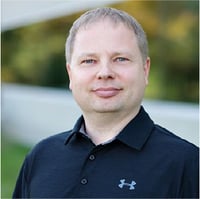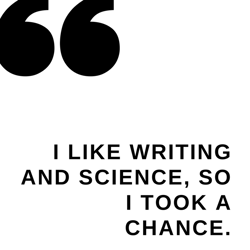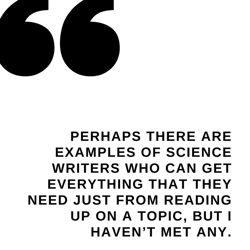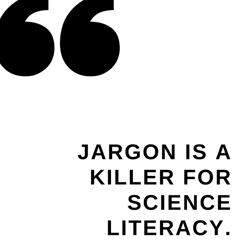 This series was written for selfish reasons: I wanted to learn about careers in science communication. When I started my Science Communication Internship with Addgene, I didn’t know a lot about scicomm, but had enjoyed writing a few Addgene guest blog pieces. Throughout my internship, my interest in scicomm has grown and now it feels like an awesome bionerd hobby but also a viable away-from-the-bench career option. So if you’re interested in learning more about science communication careers, you’re in the right place. For this series, I’ll interview three science communicators who work in the biotech, education, or nonprofit industries.
This series was written for selfish reasons: I wanted to learn about careers in science communication. When I started my Science Communication Internship with Addgene, I didn’t know a lot about scicomm, but had enjoyed writing a few Addgene guest blog pieces. Throughout my internship, my interest in scicomm has grown and now it feels like an awesome bionerd hobby but also a viable away-from-the-bench career option. So if you’re interested in learning more about science communication careers, you’re in the right place. For this series, I’ll interview three science communicators who work in the biotech, education, or nonprofit industries.
First up is Hans Packer - science writer
When Hans was finishing up his PhD in Molecular Neuroscience at the University of Iowa, he was like a lot of newly minted PhD’s: not sure what his next step should be. He debated taking a position as an application support/sales representative in industry or a postdoc in academia, but knew that, without a doubt, he enjoyed writing. With a bit of luck, he landed a job as a Science Writer at Integrated DNA Technologies (IDT). “It was fairly accidental. I was finishing graduate school, and didn’t have anything lined up when a good friend, who was a science writer, reached out to me. She was leaving a writing position and looking for someone who might take over. I like writing and science, so I took a chance.”
 It’s been six years since Hans took that gamble, and it’s paid off. Work is never boring. “I just keep learning on the job. It keeps it interesting.” And while his official title may be science writer, writing is just the one of the skills Hans uses for his job. “I am really more of a multimedia science communicator than a science writer these days. I do some public speaking and a bit of video work for webinars (get tips for your next science talk). I do illustrations for summarizing mechanisms and applications that are relevant to things IDT does. I also work on our website quite a bit.”
It’s been six years since Hans took that gamble, and it’s paid off. Work is never boring. “I just keep learning on the job. It keeps it interesting.” And while his official title may be science writer, writing is just the one of the skills Hans uses for his job. “I am really more of a multimedia science communicator than a science writer these days. I do some public speaking and a bit of video work for webinars (get tips for your next science talk). I do illustrations for summarizing mechanisms and applications that are relevant to things IDT does. I also work on our website quite a bit.”
Out of all of these tasks, webinars are Hans’ favorite thing to work on. “It’s one of the most challenging [parts of my job], so making it a success feels like a real accomplishment.” He started working on them shortly after joining IDT when his boss was looking for someone to take over hosting them. Since then, webinars make up a larger part of Hans’ workload. “I am currently getting abstracts and plans together for my next 4 webinars—I have them stacked close together for the next couple of months. This involves a lot of communication with the presenters, and editing of abstracts and speaker biographies.”
 During the week of our interview, Hans was also busy preparing materials for an upcoming product launch. “The writing group I am part of is responsible for checking the scientific accuracy of everything that goes on our website. We look at product pages, performance data, protocols, and even certificates of analysis.”
During the week of our interview, Hans was also busy preparing materials for an upcoming product launch. “The writing group I am part of is responsible for checking the scientific accuracy of everything that goes on our website. We look at product pages, performance data, protocols, and even certificates of analysis.”
Han’s biggest piece of advice for those looking to break into the field of science communications-- Be able to talk with people: “If you do this for a living, science writing will take you out of your realm of experience. I am away from the bench now, so I have to talk to other scientists when I am in new territory. Perhaps there are examples of science writers who can get everything that they need just from reading up on a topic, but I haven’t met any.” A few other tips: “Learn HTML, write a lot to make sure you don’t hate it, and be flexible. The best stuff that I do is not what I was hired to do.”

And when asked what tips he has for better science communication for non-scientists: “Jargon is a killer for science literacy. If people have to understand a lot of big words to access what you have written, they will never get off of the ground. So limiting that, and defining a couple of key terms is a better approach. Also, appealing images and colors draw people in. Drawing a picture of a mechanism that also looks nice is a great way to bring people in.”
Are you interested in careers outside academia like science communication? If so, let us know what types of jobs you are interested in in the comments. They could be featured in future career blog posts. And make sure to subscribe to the Career Channel of the blog so you don’t miss the next two posts of this series! Next up is Cailin Runne-Janczy, a Product Development Manager at eScience Labs, an educational company that creates hands-on science lab kits and digital curriculum to support them.
Many thanks to Hans for taking the time to speak with us! Follow Hans on Twitter @HansPacker.
Additional Resources on the Addgene Blog
- Get tips on how to do your own informational interview
- Check out this post if you debating about an academic or non-academic career
- Learn more about alternative science careers here
Resources on Addgene.org
- Learn more about careers at Addgene
Topics: Science Careers, Science Communication, Science Career Options






Leave a Comment